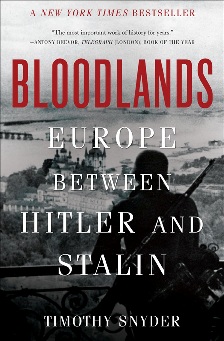History |
Bloodlands: Europe Between Hitler and Stalin
Timothy Snyder
By
Published: Mar 25, 2024
Category:
History
It’s important to understand what Putin wants with Ukraine and why “victory” is so important to him. To grasp that, you need to appreciate Ukraine’s historical importance. Here’s your cheat sheet….
Ukraine is, literally, the breadbasket of Europe. Because its rich, black soil is ideal for growing grains, it has the ability to feed half a billion people, maybe more.
Russia is the largest country in the world — twice as big as #2, Canada — but its #1 status ends there. If Russia were an American state, its GNP would be slightly larger than Florida’s.
Why is Ukraine so important to Russia?
Now we turn to Timothy Snyder,the Yale historian who wrote the indispensable On Tyranny and a dozen other books. He speaks five languages and reads ten, including Ukrainian. From a recent interview:
The Second World War was actually a colonial war and Ukraine was the main object of the war.
Hitler’s idea was that the German race had a mission, which could only be fulfilled beyond Germany. Putin has been saying that Russia only exists in so far as it absorbs Ukraine, that Russia only becomes itself when it absorbs Ukraine… It’s the dominant paradigm in Russia that this is the Second World War, and that once again Russia has been attacked by the Nazis.
Now that we’re back to the origins of all this trouble — World War II — we turn to Snyder’s “Bloodlands,” and its biggest surprise….
The Holocaust — the murder of 6 million Jews — turns out not to be the 20th century’s worst story of mass execution and the biggest story of World War II.
We know about the Holocaust because people survived it and told us about it.
We know almost nothing about what happened between 1930 and 1947 in Poland, Latvia, Lithuania, Estonia, Belarus, Ukraine, and western Russia because almost nobody survived it.
In those years, in those regions, Hitler and Stalin killed 14 million people. Not one was a soldier in uniform. Most never saw a concentration camp — they were starved, beaten, shot and gassed to death. But records are incomplete; the number could go as high as 20 million. And if the German invasion of Russia had gone as planned, Hitler would have starved 30 million just in the first winter.
“Bloodlands” tells us a story we simply don’t know. It has been honored with dozens of awards. If you want to understand the greater holocaust of the last century, it is necessary reading; if you care to contemplate “human nature,” it is even more necessary. [To buy the paperback from Amazon, click here. For the Kindle edition, click here. For the audio CD, click here.]
As Snyder writes:
Germans killed millions of Polish citizens. More Poles were killed during the Warsaw Uprising alone than Japanese died in the atomic bombing of Hiroshima and Nagasaki. A non-Jewish Pole in Warsaw alive in 1933 had about the same chances of living until 1945 as a Jew in Germany alive in 1933. Nearly as many non-Jewish Poles were murdered during the war as European Jews were gassed at Auschwitz. For that matter, more non-Jewish Poles died at Auschwitz than did Jews of any European country, with only two exceptions: Hungary and Poland itself.
Why?
Stalin started first, killing his own people — as many as 5 million — well before World War II was on the horizon. His method: starvation.
Germany’s goal was to eradicate Soviet territory and establish “pearls of settlement” — Eastern Europe would be Germany’s farm.
Snyder records all of this, in great detail, but that level of detail is the smaller of Snyder’s contributions to our understanding of what happened here. His greater and more original perception: Don’t focus just on the victims or the perpetrators. See the big picture. The Germans and Soviets were engaged in the same project: killing people at a distance. They committed similar crimes. In the end, their madness was the same.
Now Putin is running Stalin’s playbook. And now, perhaps, you understand something that half of Congress doesn’t get — it’s important that we and our allies do whatever’s necessary to keep Ukraine from becoming a satellite of Russia.


